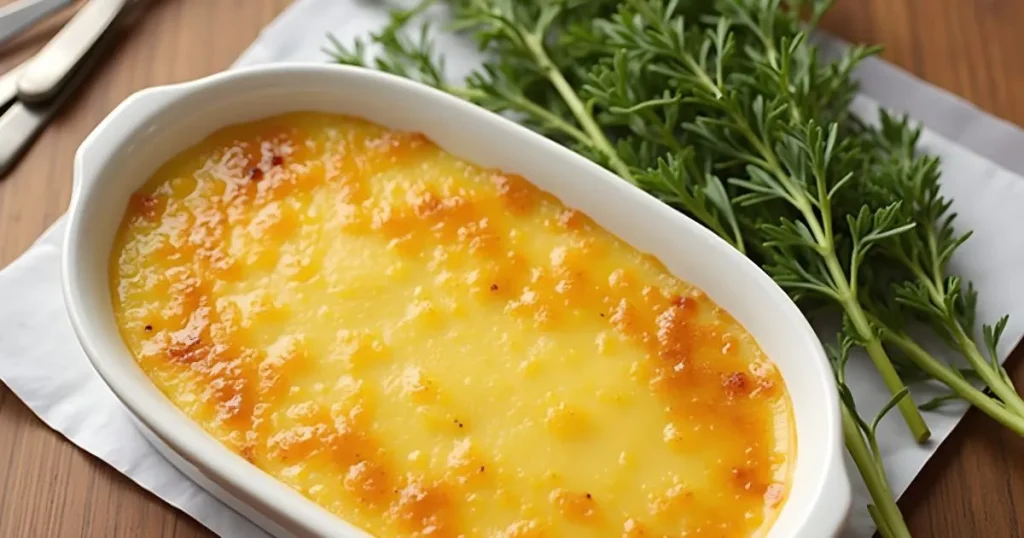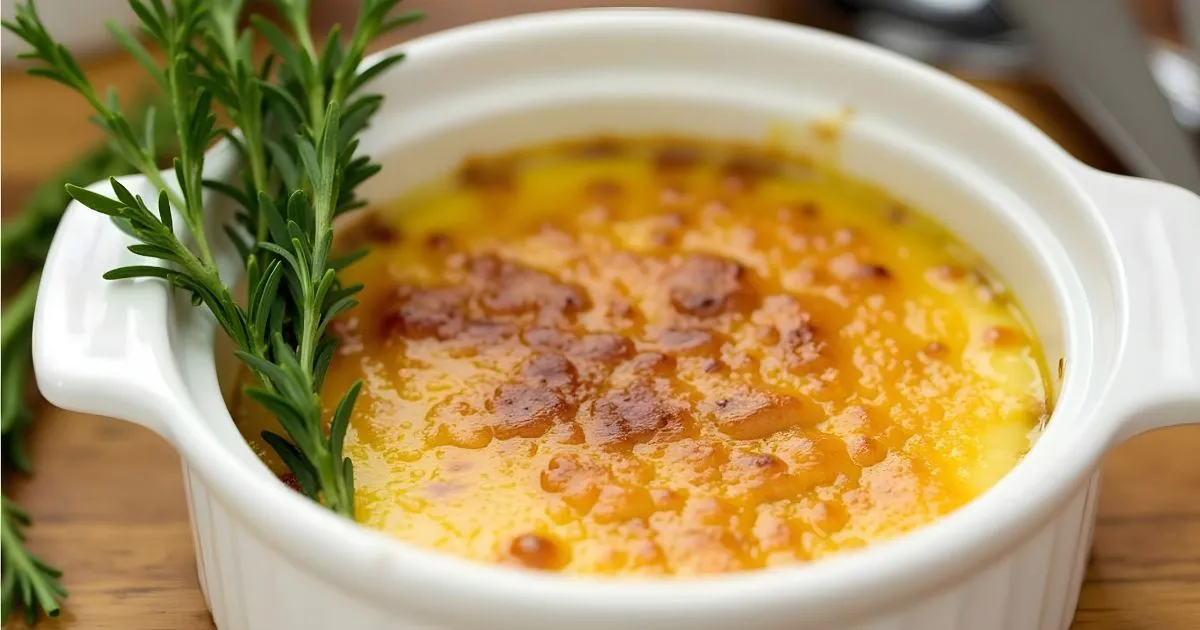The beloved crème brûlée has a savory cousin from the 17th century – bet you didn’t know that! Most people associate this French dessert with sweetness, but the crab brulee recipe turns it into an elegant seafood masterpiece.
This sophisticated dish blends fresh crab meat with a silky custard base. Sweet and briny flavors come together perfectly under that signature caramelized sugar topping. Restaurant-quality results need precise techniques. Fresh crab meat works better than canned, and the temperature must stay at exactly 300°F during baking.
You can create this impressive dish that delivers 21.6g of protein per serving. It doesn’t matter if you’re an experienced home cook or just starting your culinary experience. Want to become skilled at making the perfect crab brulee? Let’s head over to our foolproof guide!
What Makes a Crab Brulee Recipe Restaurant-Quality

The difference between an average crab brulee and a restaurant masterpiece comes down to the details. Chefs spend years becoming skilled at techniques that raise this savory seafood dish from good to extraordinary. These nuances will help you recreate that five-star experience in your kitchen.
Key Differences Between Home and Restaurant Versions
Professional kitchens put fresh ingredients first. High-quality lump crab meat gives you “hearty chunks without too many shells” and provides the “subtle sweetness” that builds the foundation of an exceptional crab brulee. Restaurant chefs pat dry their crab meat to remove excess moisture—a step many home cooks miss.
Temperature control makes professional results stand out. Restaurant kitchens keep exact control during baking, and chefs bake their crab brulees at 300°F. The water bath technique (known as a bain-marie) plays a vital role in upscale establishments because it “ensures even cooking” and stops the custard from drying out or cracking.
The custard preparation sets restaurant versions apart. Professional chefs strain their custard mixture twice to achieve silky smoothness. This focus on texture creates that signature mouthfeel you won’t find in homemade versions.
The way chefs caramelize the top might be the most noticeable difference. They know that “a thin layer of sugar is key for that delicate crisp”. Perfect caramelization comes from careful torch control, with the flame moving steadily to avoid dark spots or pale patches.
Essential Elements of a Gourmet Crab Brulee
Quality ingredients make all the difference. “For the finest crab brulee recipe results, always use fresh, never frozen crab meat. The quality of your main ingredient directly impacts the final dish’s sophistication”. Heavy cream with at least 35% fat content will give a rich and creamy texture that “provides a rich and creamy texture that balances well with the crab’s delicate sweetness”.
A restaurant-quality crab brulee should have three distinct textures:
- A silky smooth custard base with a “wobbly consistency”
- Tender chunks of sweet crab meat spread evenly throughout
- A paper-thin, crisp caramelized top that “cracks under the slightest pressure from a spoon”
The flavor balance makes the dish exceptional. Professional chefs know that “the key is layering flavors carefully so that the crab meat remains front and center”. “A tiny sprinkle of white pepper keeps the flavor savory without overpowering the crab flavor”.
Precise baking creates the perfect result. Professional kitchens take their ramekins out “when they are set but still slightly jiggly in the center”. The right ramekin choice matters—”too shallow and your custard won’t set properly, too deep and you’ll lose the ideal custard-to-caramel ratio”.
Restaurant presentation adds the final touch. Professional crab brulees come in matching ramekins with an even caramelized top. This eye for detail turns a delicious dish into an unforgettable experience.
Practice helps perfect these elements. Understanding what sets restaurant quality apart from homemade versions will help you create an impressive crab brulee in your kitchen.
Gathering Your Ingredients and Tools
Let’s get ready to make an amazing crab brulee. You’ll need the right ingredients and tools to nail this savory twist on the classic dessert. Here’s everything you need to create a restaurant-worthy dish.
Complete Shopping List
Quality ingredients are the foundations of an exceptional crab brulee. Here’s what you need to serve four people:
For the Custard Base:
- 1 cup fresh crab meat (lump or jumbo lump preferred)
- 4-5 large egg yolks
- 1-2 cups heavy cream (with at least 35% fat content)
- ¼ teaspoon salt (kosher or sea salt recommended)
- ¼ teaspoon white pepper (black works too, but white prevents visible specks)
- Optional additions: ½ tablespoon finely chopped pickled ginger, 2 minced garlic cloves, 1 tablespoon lemon zest
For Flavor Enhancement:
- 2 tablespoons grated parmesan cheese
- Fresh herbs such as chives or parsley
- Optional: 4 strips of cooked bacon
For Caramelized Topping:
- 2 tablespoons granulated sugar
- Alternatively: raw or turbinado sugar (burns more evenly)
Fresh crab makes a huge difference in your final dish. While frozen crab can work in a pinch, fresh crab gives you that superior flavor you’re looking for.
Kitchen Equipment You’ll Need
You’ll need specific tools to make this dish shine:
Baking Essentials:
- 4 ramekins (5-6 oz, shallow ones preferred for better sugar-to-custard ratio)
- Roasting tray or baking dish (deep enough for a water bath)
- Mixing bowl (glass or stainless steel)
- Whisk for combined ingredients
- Fine mesh strainer (to get that perfectly smooth custard)
Finishing Tools:
- Kitchen torch (a vital tool for caramelizing the sugar topping)
- Alternatively: a broiler with accurate temperature control
Additional Helpful Items:
- Glass measuring cup for pouring custard into ramekins
- A small saucepan for heating cream
A water bath (bain-marie) setup is a must for professional results. This method “provides gentle, even distribution of heat so the filling cooks uniformly and keeps the smoothest possible texture”. The extra humidity also stops your custard from forming a skin.
Budget-Friendly Alternatives That Work
You don’t need to spend a fortune to make great crab brulee. Here are some smart swaps:
Ingredient Alternatives:
- Use “special” or “backfin” crab meat instead of expensive jumbo lump
- Regular salt works instead of kosher or sea salt (just use half the amount)
- Mix half-and-half and butter as a substitute for heavy cream
Equipment Substitutions:
- A wide ceramic or glass dish works if you don’t have ramekins
- Your oven’s broiler can do the job of a kitchen torch with careful watching
- A fine-mesh tea strainer is enough to replace specialized strainers
Some things you just can’t compromise on. Fresh or quality frozen crab makes the difference between an okay dish and an amazing one. Save money on tools rather than key ingredients.
Timing plays a huge role in the final result. Let your crab brulee chill overnight before adding the sugar layer. This patience ended up being what sets apart a great dish from an average one.
Preparing the Best Crab Brulee Base
The perfect crab brulee needs precision and careful attention to detail. Restaurant-quality results start with the base preparation. Your success depends on how you handle the delicate crab meat and achieve that silky custard texture that makes this elegant dish special.
Cleaning and Preparing Crab Meat
An exceptional crab brulee recipe starts with fresh crab meat at its heart. We used jumbo lump crab to create impressive chunks throughout the custard. This variety gives you large pieces of sweet, tender meat that create the most luxurious eating experience.
Take time to check your crab and remove any leftover shell fragments. Use paper towels to pat the meat dry and get rid of extra moisture. This vital step keeps your custard from becoming watery. Handle the meat gently to preserve those beautiful lumps of crab that make your dish stand out.
Let your crab meat reach room temperature before you mix it into the custard base. This simple step helps the flavors blend better and ensures even cooking.
Creating a Silky Smooth Custard
Your crab brulee’s success depends on its custard foundation. Heat cream in a saucepan until tiny bubbles appear around the edges. Take it off the heat right before it starts to boil.
In a separate bowl, whisk egg yolks until they become smooth and slightly lighter. Now comes the tempering process. Pour the warm cream into the egg mixture slowly as you whisk continuously. This gentle approach stops the eggs from scrambling and creates that silky texture you want.
Strain everything through a fine-mesh sieve. This step gets rid of any lumps or bits of cooked egg, giving you that smooth restaurant-quality finish.
Flavor Infusion Techniques
The right flavors will elevate your crab brulee. A pinch of salt and white pepper creates your baseline seasoning. White pepper works better since it won’t leave black specks in your elegant custard.
Fresh lemon zest adds brightness to balance the rich, creamy base. This light acidity complements the crab meat’s natural sweetness.
You can add more depth with:
- A tiny sprinkle of nutmeg to add warmth
- Fresh chives to brighten the dish
- A touch of Dijon mustard to create complexity
Put crab meat in each ramekin until it’s half full, then pour your custard mixture over it. Tap the ramekins lightly to get rid of air bubbles before you start baking.
The water bath (bain-marie) technique is a must. This method keeps the temperature steady while baking and provides gentle, even heat that stops your custard from curdling or getting rubbery.
Foolproof Baking Method for Perfect Results
A perfect crab brulee depends on your baking technique. My experience with this dish has taught me that a water bath method makes the difference between amateur attempts and restaurant-quality results.
Setting Up the Ideal Water Bath
The proper water bath (bain-marie) creates gentle, even heat that results in silky-smooth custard. Your filled ramekins should sit in a deep baking dish or roasting tray. Hot water should reach halfway up the ramekins’ sides. The water needs to be hot but not boiling.
These professional tips will help prevent water from splashing into your custard:
- Put the baking dish in the oven before adding water
- Create a protective “fence” with aluminum foil that extends above the ramekins’ rims
- Place a kitchen towel under the ramekins so they don’t slide
Temperature and Timing Guidelines
Your crab brulee recipe needs precise timing and temperature. Set your oven to exactly 325°F (165°C). Baking takes 30-40 minutes based on your ramekin size. Some chefs prefer a gentler approach at 300°F for 25-30 minutes.
Let your custards cool at room temperature for about 30 minutes. They need at least 4 hours in the refrigerator, though overnight chilling brings out the best flavors.
Visual Cues for Doneness
The perfect custard shows these signs:
- Set edges with a slight wobble in the center
- A uniform “jiggle like jello, not wiggle like a wave”
- A glossy surface without any color change
That slight wobble shows your custard will set perfectly while cooling. Start checking at the 25-minute mark. A Jell-O-like consistency means it’s slightly overcooked but still usable. Rising custard indicates overcooking and needs a fresh start.
Creating the Signature Caramelized Topping
A perfect crab brulee’s signature feature is its caramelized sugar topping. You’ll know it’s done right when you hear that satisfying crack before your spoon hits the creamy custard underneath. Getting this crucial element right needs the right ingredients and technique.
Sugar Options and Application Methods
White granulated sugar works best to caramelize your crab brulee. We used it because it melts evenly and caramelizes at a predictable rate without burning too fast. Brown sugar isn’t a good choice since it burns at 250°F – that’s 100 degrees lower than white sugar’s burning point. This leads to dark, uneven spots. You should also skip powdered sugar because it soaks up moisture from the custard and won’t caramelize properly.
Here’s the quickest way to apply sugar:
- Put a thin, even layer (about 1 teaspoon per ramekin)
- Give the ramekin a gentle tap to spread the sugar evenly
- Make sure you cover the whole surface to get consistent results
Caramelization Techniques Without a Torch
A kitchen torch gives you the most control and even results. In spite of that, you have other options that work well too.
Your broiler can do a decent job. Just put the ramekins under a preheated broiler to name just one example, see how 1-2 minutes works. Put the rack close to the heat source and rotate if needed for even caramelization. Keep a close eye on it – sugar can go from perfect to burnt in seconds.
The hot spoon technique is a great alternative if you don’t have a torch. Heat a large cooking spoon over your stovetop flame and press it onto the sugar-topped custard. This method is available to everyone and works reliably.
Troubleshooting Common Caramelization Problems
Your caramelization might turn out uneven if you hold the torch too close or move it erratically. The solution is to keep the flame a few inches away and move it in circles. Soft sugar toppings happen when you caramelize too early – the sugar starts soaking up moisture from the custard and loses its crunch.
Burnt spots aren’t the end of the world. Just scrape off the burnt sugar and try again with a fresh layer. On top of that, it’s important to caramelize right before serving. Even a perfect crust starts getting soft after 20-30 minutes.
Practice makes perfect with that signature crack. Pay attention to these details and you’ll get restaurant-quality results every time.
Serving Your Easy Crab Brulee Recipe
A perfect caramelized crust on your crab brulee takes this dish from excellent to extraordinary. The right timing will give you that magical contrast between the warm, crispy top and the cool, creamy custard beneath. Serve it right after caramelizing the sugar.
Your presentation should start with each ramekin placed on an elegant plate. A light sprinkle of finely chopped herbs adds visual appeal and flavor. The delicate sweetness of crab pairs well with chives, and a light drizzle of infused oil makes the dish look even more appealing.
These classic accompaniments will help you get the most out of your dish:
- Lightly toasted bread or crackers to scoop the creamy custard
- Pickled cucumber that contrasts with the rich texture
- A simple salad with citrusy dressing that balances the decadence
- Lemon wedges on the side that brighten flavors
The right beverage will raise your crab brulee experience. A crisp white wine like Pinot Grigio or Sauvignon Blanc makes a perfect match. Non-alcoholic drinkers might enjoy a cold citrus-infused sparkling water that provides contrast without overpowering the delicate flavors.
This recipe works great for entertaining. You can prepare and bake the custard bases up to 24 hours before serving. Just save the final caramelization for right before the presentation. Keep your covered ramekins at 38-40°F, away from strong odors and moisture.
Take the ramekins out 20 minutes before serving to reach the ideal temperature. The custard should never be warmed – just add the caramelized top right before serving. This timing creates that perfect texture contrast that makes crab brulee special.

